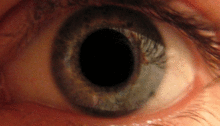Task-invoked pupillary response

Task-invoked pupillary response (also known as the "Task-Evoked pupillary response" is a pupillary response caused by a cognitive load imposed on a human and as a result of the decrease in parasympathetic activity in the peripheral nervous system.[1] It is found to result in a linear increase in pupil dilation as the demands a task places on the working memory increase. Beatty, J.[2] evaluated task-invoked pupillary response in different tasks for short-term memory, language processing, reasoning, perception, sustained attention and selective attention and found that it fulfils Kahneman’s[3] three criteria for indicating processing load. That is, it can reflect differences in processing load within a task, between different tasks and between individuals. It is used as an indicator of cognitive load levels in psychophysiology research.
References
- ^ [1] Kramer, A. F., 1991. Physiological metrics of mental workload: A review of recent progress. In: Damos, D. L. (ed.) Multiple-task Performance. London: Taylor & Francis Ltd.
- ^ [2] Beatty, J., 1982, Task-evoked pupillary responses, processing load, and the structure of processing resources. Psychological Bulletin, 91, 276-292.
- ^ [3] Kahneman, D., 1973, Attention and effort, Englewood Cliffs, N. J., Prentice-hall.
